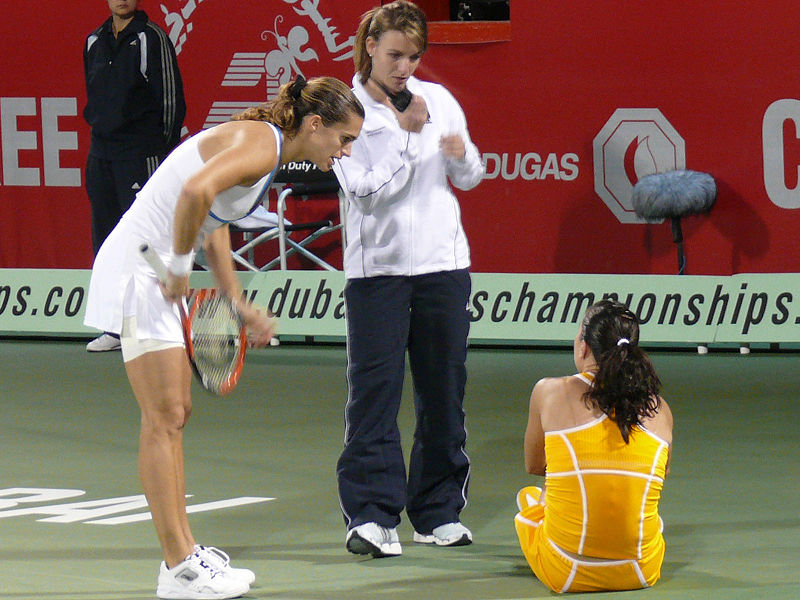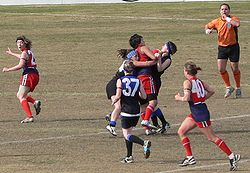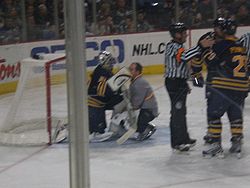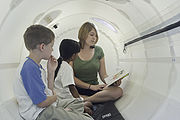Sports injury: Difference between revisions
No edit summary |
No edit summary |
||
| Line 67: | Line 67: | ||
*[[Concussion grading systems]] | *[[Concussion grading systems]] | ||
*[[Sports medicine]] | *[[Sports medicine]] | ||
*[[Prolotherapy]] | |||
*[[Diagnostic musculoskeletal ultrasonography]] | |||
== External links == | == External links == | ||
Revision as of 02:29, 17 May 2009
|
WikiDoc Resources for Sports injury |
|
Articles |
|---|
|
Most recent articles on Sports injury Most cited articles on Sports injury |
|
Media |
|
Powerpoint slides on Sports injury |
|
Evidence Based Medicine |
|
Clinical Trials |
|
Ongoing Trials on Sports injury at Clinical Trials.gov Trial results on Sports injury Clinical Trials on Sports injury at Google
|
|
Guidelines / Policies / Govt |
|
US National Guidelines Clearinghouse on Sports injury NICE Guidance on Sports injury
|
|
Books |
|
News |
|
Commentary |
|
Definitions |
|
Patient Resources / Community |
|
Patient resources on Sports injury Discussion groups on Sports injury Patient Handouts on Sports injury Directions to Hospitals Treating Sports injury Risk calculators and risk factors for Sports injury
|
|
Healthcare Provider Resources |
|
Causes & Risk Factors for Sports injury |
|
Continuing Medical Education (CME) |
|
International |
|
|
|
Business |
|
Experimental / Informatics |
Editor-In-Chief: C. Michael Gibson, M.S., M.D. [1]
Please Take Over This Page and Apply to be Editor-In-Chief for this topic: There can be one or more than one Editor-In-Chief. You may also apply to be an Associate Editor-In-Chief of one of the subtopics below. Please mail us [2] to indicate your interest in serving either as an Editor-In-Chief of the entire topic or as an Associate Editor-In-Chief for a subtopic. Please be sure to attach your CV and or biographical sketch.
Overview



Sports injuries are injuries that occur to athletes in major sporting events. In many cases, these types of injuries are due to overuse of a part of the body when participating in a certain activity. For example, runner's knee is a painful condition generally associated with running, while tennis elbow is a form of repetitive stress injury at the elbow, although it does not often occur with tennis players. Other types of injuries can be caused by a hard contact with something. This can often cause a broken bone or torn ligament or tendon
Injuries are a common occurrence in professional sports and most teams have a staff of Athletic Trainers and close connections to the medical community. Controversy has arisen at times when teams have made decisions that could threaten a players long-term health for short term gain.
Classification
Sports injuries can be broadly classified as either traumatic or overuse injuries. Traumatic injuries account for most injuries in contact sports such as Football, Rugby, Australian rules football, Gaelic football and American football because of the dynamic and high collision nature of these sports. These injuries range from bruises and muscle strains, to fractures and head injuries.
A bruise or contusion is damage to small blood vessels which causes bleeding within the tissues. A muscle strain is a small tear of muscle fibers and a ligament sprain is a small tear of ligament tissue. The body’s response to these sports injuries is the same in the initial five day period immediately following the traumatic incident - inflammation.
Signs and symptoms
Inflammation is characterized by pain, localized swelling, heat, redness and a loss of function.
Mechanism
All of these traumatic injuries cause damage to the cells that make up the soft tissues. The dead and damaged cells release chemicals, which initiate an inflammatory response. Small blood vessels are damaged and opened up, producing bleeding within the tissue. In the body’s normal reaction, a small blood clot is formed in order to stop this bleeding and from this clot special cells (called fibroblasts) begin the healing process by laying down scar tissue.
The inflammatory stage is therefore the first phase of healing. However, too much of an inflammatory response in the early stage can mean that the healing process takes longer and a return to activity is delayed. The sports injury treatments are intended to minimize the inflammatory phase of an injury, so that the overall healing process is accelerated.
Prevention
A comprehensive warm-up programme has been found to decrease injuries in soccer.[1] Many athletes will partake in HGH Treatment for Athletic Enhancement as a way to prevent injuries.
Treatment
Sports injuries can be treated and managed by using the P.R.I.C.E.R... DR. ABC and T.O.T.A.P.S regimes:
- P - Protect
- R - Rest
- I - Ice
- C - Compression
- E - Elevation
- R - Referral
- D - Danger
- R - Response
- A - Airway
- B - Breathing
- C - Circulation
- T - Talk
- O - Observe
- T - Touch
- A - Active movement
- P - Passive movement
- S - Skills test
The inflammatory stage typically lasts around 5 days and all treatment during this time is designed to address the cardinal signs of inflammation – pain, swelling, redness, heat and a loss of function.
Compression sportswear is becoming very popular with both professional and amateur athletes. These garments are thought to both reduce the risk of muscle injury and speed up muscle recovery.

Although not proven some professional athletes use hyperbaric chambers to speed healing. Hines Ward of the Steelers sent his personal hyperbaric chamber,(similar to the one pictured), to his hotel to sleep in believing it would help heal his sprained medial collateral ligament he suffered in their playoff win against the Ravens. Hines went on to play in Super Bowl XLIII.
References
- ↑ Soligard T, Myklebust G, Steffen K; et al. (2008). "Comprehensive warm-up programme to prevent injuries in young female footballers: cluster randomised controlled trial". BMJ. 337: a2469. doi:10.1136/bmj.a2469. PMID 19066253.